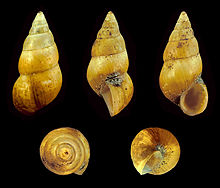Hydrobia ulvae
| Peringia ulvae | |
|---|---|
 |
|
| A shell of Peringia ulvae | |
| Scientific classification | |
| Kingdom: | Animalia |
| Phylum: | Mollusca |
| Class: | Gastropoda |
| (unranked): |
clade Caenogastropoda clade Hypsogastropoda |
| Superfamily: | Truncatelloidea |
| Family: | Hydrobiidae |
| Genus: | Peringia |
| Species: | P. ulvae |
| Binomial name | |
|
Peringia ulvae (Pennant, 1777) |
|
| Synonyms | |
|
|
clade Hypsogastropoda
clade Littorinimorpha
Peringia ulvae, also known as Peringia ulvae, common name the Laver spire shell or mudsnail, is a European species of very small aquatic snail with gills and an operculum, a gastropod mollusk in the family Hydrobiidae.
This is arguably a marine snail, but it is often also listed as a non-marine species because it tolerates brackish water and lives in salt marshes and similar habitats.
When it is within the genus Peringia, this species is the type species of the genus Peringia.
This species occurs on the coasts of the Baltic Sea, the White Sea the Eastern Atlantic and the western Mediterranean Sea, (the Mediterranean records may be in error) including:
The type locality is "on the shores of Flintshire", Wales, United Kingdom. The distribution type is Oceanic Wide Temperate
This species was originally described by Welsh naturalist Thomas Pennant in 1777. Pennant's original text (the type description) reads as follows:
Ulvae.
T. with four spires, the first ventricose; of a deep brown color; aperture oval.
Size of a grain of wheat.
Tab. lxxxvi. fig. 120.
Inhabits Ulva Lactuca on the shores of Flintshire.
...
Wikipedia
